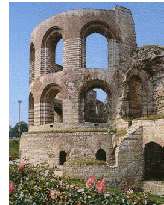
Besides the construction of an Imperial Palace (Elector's Palace), the building of palatial Imperial baths was another ambitious project within the enormous building programme of the Imperial Roman period during the first half of the 4th century, and the Thermae of Trier counted among the most spacious in the whole Roman Empire. The Imperial Thermae are not far from the Amphitheatre, at the edge of the Palace Garden. But even before being completed, the whole reconstruction of the new building was well on the way. So far, no clues have been found, pointing to their further use, but it seems fairly probable that their connection with the complex of the Imperial Palace was somehow maintained.
The planning and general lay-out of its available space was guided by and based upon only two principles: size and symmetry. The hot-water baths (Caldarium), a hall containing a huge semicircular pool on the long east wall of the rectangular building, and two smaller pools along the shorter wall are the best preserved part of the Thermae.
The far-spreading network of corridors in the builing's basement, almost as intricate as a labyrinth - they are now reexcavated and can be entered - were necessary for the maintenance of the heating system and also, for the drainage of the waste-water from the baths, while at the same time providing access to the stairtowers and lightshafts. The many finds made in the Thermae give ample proof of the display of luxury in connection with the Thermae's interior decoration: of walls panelled with marble, of mosaics and sculptures in profusion.
| |

Baths of Constantine
Augusta Treverorum, the largest Roman bath complex north of the Alps, c. 310.

Same Scale Comparison, Baths of Diocletian, Rome, c. 302, Imperial Baths, Trier, c. 310
 
Visual Comparison, Imperial Baths, Trier, c. 310, Torre Pignattara, Rome, c. 320-26

|